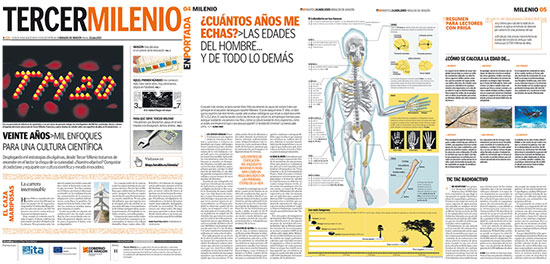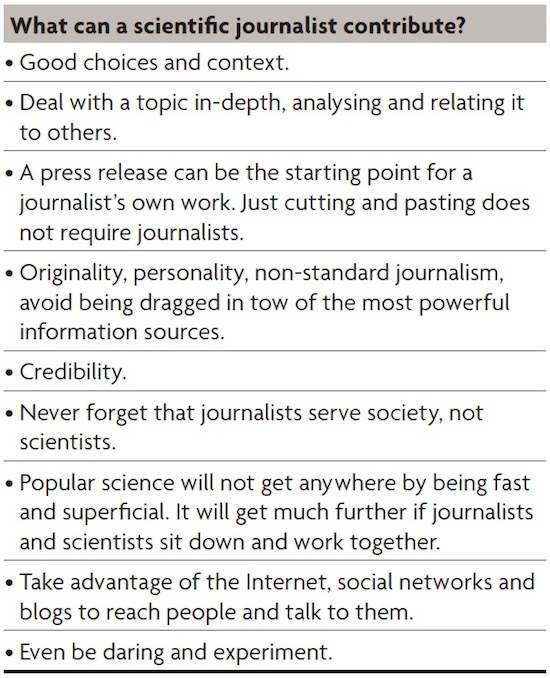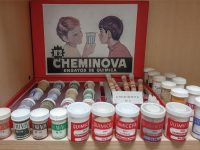The conquest of readers
Evolutionary challenges of science communication in an extreme environment

ABSTRACT
The huge responsibility of the media lies in the fact that citizens have the right to science information, to help them take better decisions, nurture a critical spirit, and form their own opinions; to update their knowledge and make them part of the culture of their time. Nowadays, the written press faces a rapidly changing and competitive environment, threatening the survival of traditional science communication. Professionally speaking, this is the moment for science communication to evolve, but also to keep the essential element: the root of good journalism, to stand out for quality and boldness, in order to be readers’ choice. There is still room for development, production, communication craftsmanship and profession. Keywords: communication, science communication, media, science journalism.
We have all made a paper hat with a sheet of newspaper at some time or another. Those of us who cover those papers in inky words and fill them with our messages do so in the hope they will fly as far as the best folded paper aeroplane. Origami has been defined as «the universe on a piece of paper» because it contains all figures and none at all, figures shared by thousands of hands over time. Like masters of origami, journalists also seek to portray the world on a sheet of paper, tell stories, share ideas, then, each one can be folded, unfolded or transformed. Science communication is one of the myriad colours forming the great tapestry of the world around us.
Because science is «our thing», every time I meet restless students at the University of Experience, I start with this idea. I tell them that at the José María Savirón Outreach Awards 2011, the director of the past programme RTVE Tres14, Ana Montserrat, recounted how five babies had been born to the Tres14 team in the last four years. The daily meetings of journalists and scientists who made up the team were no longer the same: that change in their lives had made them become interested in the future «because they had children». «We started asking questions about the challenges society must face, major problems related to food, energy, pollution, curing diseases… Science must get ahead of the problem and solve it, make no mistake.»
«Huge problems can only be solved by science. But science is part of society, and societies must value science, give it the means to move forward»
Surely, these huge problems can only be solved by research, by science. But science is part of society, and societies must value science, give it the means to move forward and finally take decisions to prevent, mitigate or solve each problem.
This is one reason why responsible citizens should be able to assess the role and value of science, which is largely funded by public money, so they can demand from those who govern policies and budgets in accordance with this value (Calvo Hernando, 1997). Furthermore, many social debates are grounded in scientific and technological issues: ranging from GMOs to drones and from cyber espionage to homeopathy. Indeed, you cannot have an opinion about something you know nothing about (Calvo Hernando, 2005).
The layperson’s scientific literacy is shaped largely by the media (De Semir, 2007). What the media recounts «exists» and can reach and impact large audiences. «Science that counts is science that recounts» says the journalist Elena Sanz simply (Sanz, 2013).
Because, as well as scientific communication recounted by the source itself, specialized blogs, science museums… the mass media is a gateway for us all, not just for those who are already interested (Elias, 2003). Somewhere the public can meet science, even without looking for it.
It would be a good idea if we were to launch, together, what – in the past science supplement El Correo – the physicist and director of Euskampus Igor Campillo called «a continuous drizzle, a light rain of simple concepts, relentlessly falling gently from all communications media onto the public, soaking them in science» (Campillo, 2012).
But are people interested in science? There is a segment of the public that is extremely interested, faithful to popular science magazines. In Spain, for instance, two million people read the magazine Muy Interesante every month, while others enjoy watching a good documentary or have science blogs among their favourite sites. There is also momentary interest: we all love to satisfy our curiosity about news on volcanic eruptions today, for example. And then again, there are people who do not realise they are interested in science because they do not see it woven into everyday news and many things that affect them directly.
Recent studies confirm the classic deficit in information compared to interest in science. An international study of scientific culture (Estudio internacional de cultura científica, Fundación BBVA) reveals that people are interested in scientific issues but feel they are not so well informed. In Spain, on a scale from 0 to 10, people ranked their interest at 5.7 and information at 4.7 (Fundación BBVA, 2012).
Another survey on the social perception of science and technology run by the Spanish Foundation for Science and Technology (VI Encuesta de percepción social de la ciencia y la tecnología, Fecyt, 2012) shows that interest in science and technology is increasing in Spain. Generally speaking, it has increased by 19% since 2010, and 40% among 15 to 24-year olds.
Growing interest is obviously positive, and an information deficit seems to demand more scientific content. However, if we look at the specifics, we see that the percentage of respondents who spontaneously mentioned science and technology among the three topics that interested them the most was only 15.6%, reaching 24.3% for young people.
Meanwhile, the statistic for journalists is very disquieting as 24.9% admitted to having little or no interest in these topics, and justified their stance by saying they did not understand them. So, bearing in mind that science and technology has many ingredients to seduce the public – novelty, variety, knowing what happens and what will happen to us, mystery, the human aspect, beauty – we should ask ourselves: how can we improve the media in this respect?
Another fact is particularly relevant: Internet now ranks first, beating television as the primary source of scientific information. In particular, social networks come first as a channel of scientific information for those under 25 years of age. The mainstream media have lost ground, while increasing the use of digital media on science and blogs (Casero-Ripollés, 2012; FECYT, 2012).
All this information reveals some of the key challenges facing science communication in the press today.

Tercer Milenio is a science supplement, published every Tuesday by the newspaper Heraldo de Aragon, which turned twenty in 2013. Its pages are a commitment to standing out and being creative, with journalists working in close collaboration with scientists.
CROSSROADS
Alice looked round her in great surprise.
«Why, I do believe we’ve been under this tree the whole time! Everything’s just as it was!»
«Of course it is,» said the Queen, «what would you have it?»
«Well, in our country,» said Alice, still panting a little, «you’d generally get to somewhere else — if you ran very fast for a long time, as we’ve been doing.»
«A slow sort of country!» said the Queen. «Now, here, you see, it takes all the running you can do, to keep in the same place. If you want to get somewhere else, you must run at least twice as fast as that!»
Lewis Carroll, Through the Looking-Glass
and What Alice Found There.
Lewis Carroll’s baffled and breathless Alice could well be one of the images we see today in the mirror of science journalists. Indeed, evolution and adaptation to the environment are vital for any species to survive. The environment is changing and extreme. In this fierce evolutionary adaptation, at times we must give some things up, but without others survival would be impossible.
Journalism, in general, and science journalism in the written press, in particular, is at a crossroads where three paths meet: the twin crisis – i.e. the economic one and the media’s business model; new challenges implicit in the digital world; and the challenge of conquering a much sought-after audience or readership.
Both challenges and opportunities arise. It is time to evolve but also to rescue the core values of journalism. We should ask ourselves a number of questions: can the pace at which the media evolve keep up with the world around us? Are we able to preserve the values that would make us strong, and those sought by the public, in an increasingly rich and therefore more competitive environment?
Alarmingly, precariousness is on the rise at a time when there is the potential for good science journalism, with more journalists than ever before and scientists’ attitude to dissemination improving steadily. Science, however, is seen as a dispensable luxury, workers are dismissed, specialized supplements close down, and the columns devoted to science fade from the newspapers. Antonio Calvo Roy, president of the Spanish Association for Scientific Communication (Asociación Española de Comunicación Científica) speaks of «austericide» in newsrooms. He says that science is still the poor relation of the mass media. Scientific news must have huge relevance in order to take a prominent place in a newspaper (Perla Mateo, 2013a).
«The main role of journalists is to locate, relate and ask questions that nobody else has asked, or that everyone is asking»
Too often, it does not matter how much you are worth, but how much you cost. According to this criterion, experienced professionals find themselves queuing in the unemployment lines, while those who do keep their jobs accept working conditions that steadily deteriorate: we have more work and fewer people to do it, and the pay is worse. The pressure on professionals has increased. Patricia Fernández de Lis, director of Materia, says «science journalists are rare birds. Large newsrooms are dismissing specialists because they are expensive to train and maintain» (Perla Mateo, 2013b).
At the same time, we live in times of uncertainty in the sector. New business models are sought by the printed press and online formats, but if they do not take great care of the quality of the journalistic content, they will have no product to sell (Perla Mateo, 2011).
Meanwhile, science and technology centres (universities, research centres, space agencies…) (Elías, 2008) communicate with the public directly through their own websites. Indeed, the press releases reaching the media are already so comprehensive and well-written that journalists too often succumb to the temptation to «cut-and-paste», which is both cheap and practical for business. One wonders whether journalists are still really necessary as intermediaries between science and society (De Semir, 2010). The mass media still have much to contribute, provided they are not just conveyer belts for other people’s messages; messages without explanation, without assimilation, without analysis.
In this context, press releases made from press offices «colonize the agenda». This was revealed by the focus group, working within the framework of the II Gutenberg Campus, Pompeu Fabra University, held in September 2012 to reflect on the state of science journalism in Spain. Several problems were discussed. The journalist Gonzalo Casino stated that «professional distances from the source are not kept». In his opinion, «we cannot strike the right balance between distrust and excessive intimacy». According to Joaquim Elcacho, «today there are no journalists who question the scientist’s voice». For Casino this means that «we were half-baked scientific journalists, abounding in friendly dissemination, with barely any room for critical journalism when the crisis swept us away».
Self-criticism was also directed at the way in which scientific content is presented, often without sufficient context, in the words of Vladimir de Semir, director of the Science Communication Observatory(De Semir, 2010).
This anecdotal abundance of content is linked to an extreme swing towards the consumption of fast food information, highlighted by new mobile applications.

Taula 1. El periodisme científic ha de seguir una sèrie de criteris a l’hora de plantejar la informació amb l’objectiu de conquistar nous segments de públic.
HUNTERS AND GATHERERS
Perhaps, the first scientists were the men or women who painted hunting scenes on the walls of their caves, given their ability to observe and to abstract the world around them. It is clear that journalists can be hunters or collectors of stories, or farmers with homespun yarns. But we all share the same goal: to conquer the reader.
To do a job well one must be a selective seeker and act as a mirror of the best one finds. But considering journalism as a creative activity, then the main role of journalists and disseminators as creators – besides documenting, confirming and putting into context – is to locate, relate and ask questions that nobody else has asked, or that everyone is asking. And finally, give the journalist’s own responses and original proposals.
We should appreciate the fact that information sources provide increasingly better material, but this should not impoverish science dissemination or journalism. In a world where the public is bombarded with thousands of stimuli, only those that stand out have a chance of being chosen. Besides the high quality information that many scientific institutions offer online, there are other growing phenomena such as science blogs. Some of the higher quality blogs dazzle their audiences, managing to be heard, to be read and, more importantly, reviewed and linked by a group of faithful and participative followers. Nonetheless, the mass media can still offer specialized content, while continuing to be the gateway for all people to access all subjects, including science. Hence science will reach those who were not previously interested in it, and had never entered a scientific web or a specialized blog, as the mass media enters their home and rouses their interest in something they did not know existed.
This potentially wide reach, the possibility of conquering new segments of the public, will only come true if quality science journalism is presented through the proper media and with sufficient time to develop content in such a way that its stands out and offers something extra. This is something that must be understood by decision makers: publishing companies, editors and directors of mass media channels.
So, we should ask ourselves what science journalists can do. Good journalism, a commitment to quality and innovation that we can state in terms of the criteria summarized in Table 1. In short, as always, but now more than ever, we must appeal to the public, unfold a strategy to seduce our readers, which is more increasingly challenging because our readers have more suitors than ever before. We will have to be empathetic, put ourselves in our readers skin and answer the questions that the layman would ask.
Scientists explore the depths of their subject, but the layman has not done this deep-sea diving course. Indeed, sometimes, he cannot even swim. So we must offer a guided tour of the surface waters, without forgetting that scientists have seldom done a course in navigating the sea of communication1.
Science and journalism may be two different worlds, but they are not so far apart as to lose sight of one another. Tercer Milenio – published every Tuesday in the newspaper Heraldo de Aragón – has spent twenty years endeavouring to provide a supplement for readers that involves scientists. Here we work shoulder to shoulder; everything is reviewed and agreed upon and the expert is encouraged to think of the reader. Nothing is published that is hard to understand or simply boring, but rather it is worked on, edited and reedited until it can call itself a merit to popular science. This direct cooperation to develop the contents of Tercer Milenio, a painstaking task to blend effective communication with rigorous science, has bridged the gap. Its pages reflect our aim to be different and creative. At the press office we strive to be hunters of good stories, to cook new dishes with the fruits gathered here and there, and to cultivate our own style of reporting.
The extreme conditions surrounding us today make survival a merit in itself. Engineers use origami-based strategies to create dynamic structures, folded up for transport and unfolded where needed, like a coronary stent opening an artery and allowing the blood to circulate. There are so many ideas, initiatives, reports… waiting today, compacted to a minimum, to be unfolded when the time is right.
1.University of La Rioja (2011) has written a manual of online communication for researchers: Manual online de comunicación para investigadores, so those who set out to conquer the public are not attending a blind date: <http://comunicaciencia.unirioja.es/>. (Go back to text)
References
Calvo Hernando, M., 1997. Manual de periodismo científico. Editorial Bosh. Hospitalet del Llobregat.
Calvo Hernando, M., 2005. Periodismo científico y divulgación de la ciencia. ACTA-CEDRO. Madrid.
Campillo, I., 2012. «Sirimiri de ciencia». El Correo, 19 de noviembre. Disponible en: <http://ciencia.elcorreo.com/firmas/2012-11-19/sirimiri-ciencia-20121119.html>.
Casero-Ripollés, A., 2012. «Beyond Newspapers: News Consumption among Young People in the People in the Digital Era». Comunicar, 39: 151-158. DOI: <10.3916/C39-2012-03-05>.
De Semir, V., 2007. La ciencia en los medios de comunicación. Prodisa. Barcelona.
De Semir, V., 2010. Science Communication & Science Journalism. Media for Science Forum. Madrid. Disponible en: <http://www.mediaforscience.com/Resources/documentos/booklet_en.pdf>.
Elías, C., 2003. La ciencia a través del periodismo. Nivola. Tres Cantos.
Elías, C., 2008. Fundamentos de periodismo científico y divulgación mediática. Alianza Editorial. Madrid.
FECYT, 2012. VI Encuesta de Percepción Social de la Ciencia. Fundación Española para la Ciencia y la Tecnología. Madrid. Disponible en: <http://www.fecyt.es/fecyt/docs/tmp/363174605.pdf>.
Fundación BBVA, 2012. Estudio Internacional de Cultura Científica. Departamento de Estudios Sociales y Opinión Pública de la Fundación BBVA. Madrid. Disponible en: <http://www.fbbva.es>.
Perla Mateo, M. P., 2011. «Iñaki Gabilondo: el tic-tac del corazón frente a la máquina de escupir noticias». De cero a ciencia, 7 de junio. Disponible en: <http://blogs.heraldo.es/ciencia/?p=2265>.
Perla Mateo, M. P., 2013a. «Antonio Calvo Roy: "La ciencia es aún la hermana pobre de los medios de comunicación"». Heraldo de Aragón, Tercer Milenio, 19 de marzo.
Perla Mateo, M. P., 2013b. «Patricia Fernández de Lis: "El periodista científico es rara avis en las redacciones"». Heraldo de Aragón, Tercer Milenio, 18 de junio.
Sanz, E., 2013. «La ciencia que cuenta es la que se cuenta». Agencia Sinc, 4 de febrero. Disponible en: <http://www.agenciasinc.es/Opinion/La-ciencia-que-cuenta-es-la-que-se-cuenta>.





